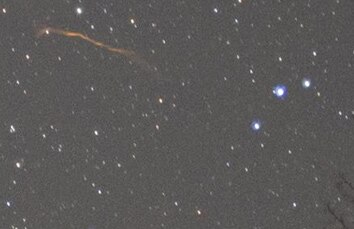Create a free profile to get unlimited access to exclusive videos, sweepstakes, and more!
Persistence Pays Off: The Smoking Trail of a Shooting Star

On Oct. 16, 2014, a redditor by the handle -545- was camping at the Ashton-Wildwood County Park in Iowa. He spotted a clearing in the trees near his campsite which framed a part of the sky, so he set his camera up to take a series of 10-second exposures in the hopes of getting good footage for a time-lapse video.
What he got was better than good: He caught a bright meteor that left a persistent train, a trail of glowing vapor that lasted for quite some time:
That’s pretty amazing timing and framing. The meteor appeared right in the middle of the hole in the trees, and the meteor must have appeared very early in the 10-second exposure that first shows it; you can already see some of the vapor trail it left behind. For those keeping track at home: The brightish star to the right of the meteor is Gamma Triangulum, the star above the middle of the streak is 1 Tri, and the little diamond to the left is 12 and 13 Tri with two fainter stars (HD15226 and HD15326); it took me a while poring over my planetarium software to nail this down!
This sort of event is pretty rare, though not unheard of (I have several blog posts showing them; see Related Posts below). A meteor is just a small chunk of rock, ice, or metal that’s orbiting the Sun, and the Earth gets in its way. As it plunges through our atmosphere at high speed, it violently compresses the air ahead of it, heating it. This in turn heats the meteoroid (the solid bit of interplanetary debris; as it burns up it’s called a meteor, and if it hits the ground it’s a meteorite), which glows and leaves behind the bright but generally short-lived trail.
But the event can also ionize the air, stripping electrons from their parent molecules. As the electrons recombine, they give off a bit of light. This is called a persistent train, and some have been known to last for many minutes. The train is roughly 80–100 km above the ground, and upper atmosphere winds blow it into twisting, eerie shapes.
-545- really nailed this one! You might think he was lucky, but it’s not luck. It’s persistence. Events like this happen, and if you go outside enough, watch the sky long enough, take enough pictures … you’ll wind up with something amazing.
And if you do see a bright meteor (sometimes called a fireball or bolide), make sure you note your time, location, and the direction you saw it. Then you can report it to the American Meteor Society, which collects these data. Sometimes this can help recover meteorites if there are any!
Tip o’ the Whipple Shield to reddit, and the many, many people who sent this my way.
Related Posts
A Meteor’s Lingering Tale
A Puff of Celestial Smoke
Like Two Trains Passing the Night … a Year Apart
A Persistent Orionid
The Remains of Halley’s Comet Burn and Linger in the Sky
Time-Lapse: YIKÁÍSDÁHÁ
Petrified


























